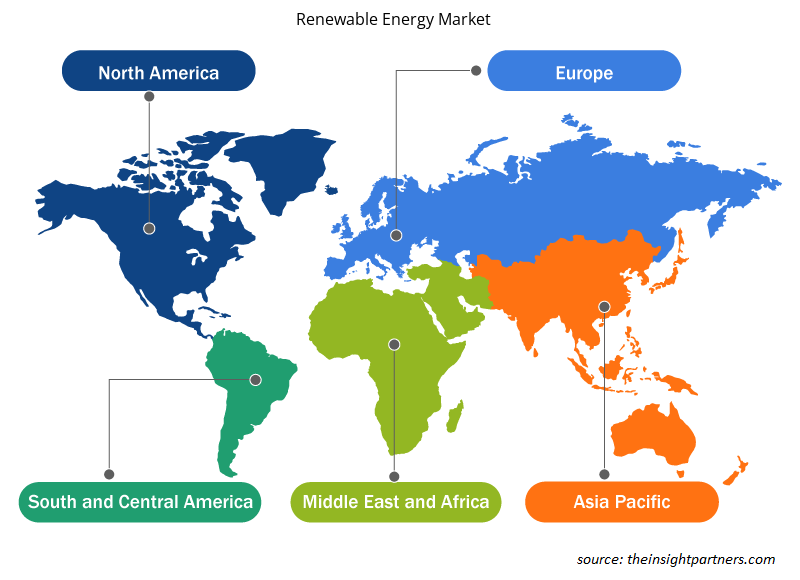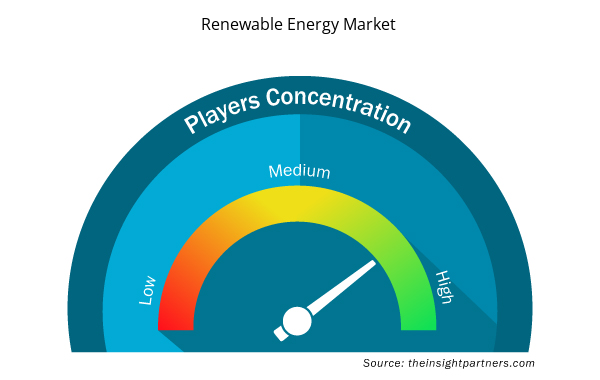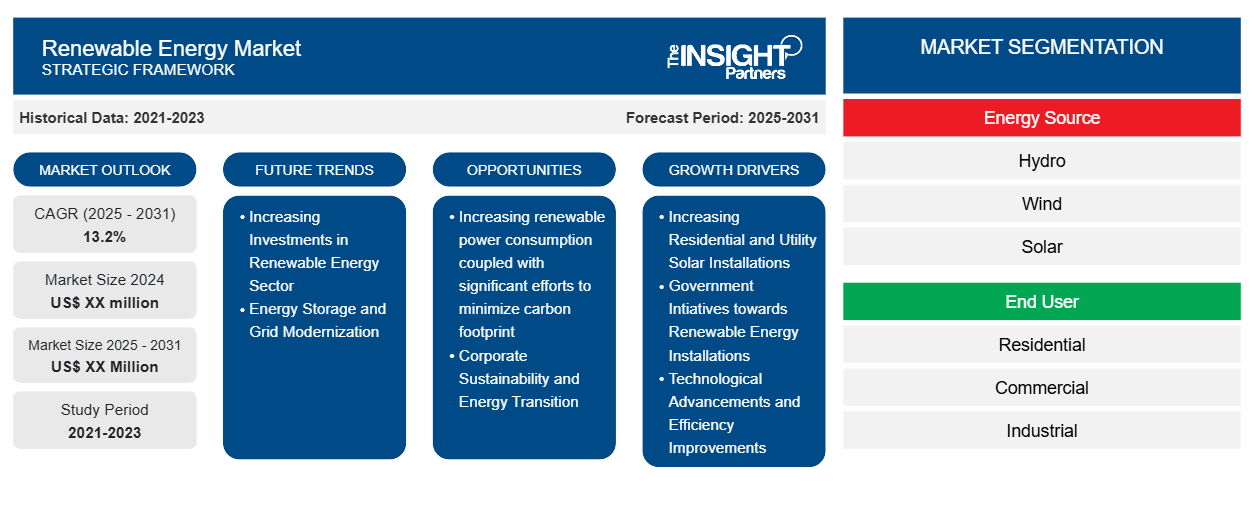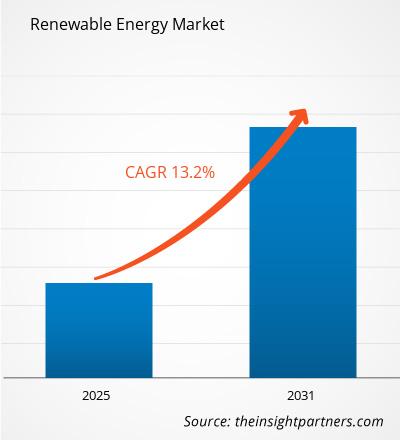Se espera que el mercado de energía renovable registre una CAGR del 13,2% entre 2023 y 2031, con un tamaño de mercado que se expandirá de US$ XX millones en 2023 a US$ XX millones en 2031.
El informe está segmentado por fuente de energía (hidroeléctrica, eólica, solar, geotérmica, otras). El informe presenta además un análisis basado en el usuario final (residencial, comercial, industrial). El análisis global se desglosa aún más a nivel regional y por países principales. El informe ofrece el valor en USD para el análisis y los segmentos anteriores.
Propósito del Informe
El informe Renewable Energy Market de The Insight Partners tiene como objetivo describir el panorama actual y el crecimiento futuro, los principales factores impulsores, los desafíos y las oportunidades. Esto proporcionará información a diversas partes interesadas del negocio, como:
- Proveedores/fabricantes de tecnología: Para comprender la dinámica cambiante del mercado y conocer las oportunidades potenciales de crecimiento, lo que les permitirá tomar decisiones estratégicas informadas.
- Inversionistas: Realizar un análisis exhaustivo de tendencias sobre la tasa de crecimiento del mercado, las proyecciones financieras del mercado y las oportunidades que existen en toda la cadena de valor.
- Órganos reguladores: Regular las políticas y vigilar las actividades del mercado con el objetivo de minimizar los abusos, preservar la confianza de los inversores y defender la integridad y la estabilidad del mercado.
Segmentación del mercado de energía renovable
Fuente de energía
- Hidroeléctrica
- Viento
- Solar
- Geotermia
- Otros
Usuario final
- Residencial
- Comercial
- Industrial
Personalice este informe según sus necesidades
Obtendrá personalización en cualquier informe, sin cargo, incluidas partes de este informe o análisis a nivel de país, paquete de datos de Excel, así como también grandes ofertas y descuentos para empresas emergentes y universidades.
- Obtenga las principales tendencias clave del mercado de este informe.Esta muestra GRATUITA incluirá análisis de datos, desde tendencias del mercado hasta estimaciones y pronósticos.
Factores impulsores del crecimiento del mercado de energía renovable
- Aumento de las instalaciones solares residenciales y de servicios públicos: el impulso creciente hacia la obtención de energía verde para lograr la sostenibilidad y la seguridad energética es el factor principal que impulsa la implementación de la energía solar fotovoltaica para satisfacer la creciente demanda y reemplazar las fuentes de generación de energía basadas en combustibles fósiles. El crecimiento se debe principalmente a los avances tecnológicos, la reducción constante de costos y la electrificación rural, que a su vez se espera que impulse el crecimiento del mercado de energía renovable en los próximos años.
- Iniciativas gubernamentales en favor de las instalaciones de energía renovable: el fuerte apoyo de las políticas gubernamentales sigue siendo el principal impulsor de la implantación de la energía solar fotovoltaica en todo el mundo. Se han implementado diversas políticas, como subastas, tarifas de alimentación, medición neta, contratos por diferencia, créditos fiscales a la inversión, créditos fiscales a la producción y objetivos de generación de energía renovable. Se espera que estas iniciativas impulsen el mercado de la energía renovable.Intiatives towards Renewable Energy Installations: Strong government policy support continues to remain as the principal driver of solar PV deployment across the world. Various policies implemented including, auctions, feed-in-tariffs, net-metering, contracts for difference, Investment tax credit, production tax credit, and renewable power generation targets. Such initiatives are expected to drive the renewable energy market.
- Avances tecnológicos y mejoras de eficiencia: Las innovaciones tecnológicas en tecnologías de energía renovable han reducido significativamente el costo y mejorado la eficiencia, haciéndolas más competitivas con las fuentes de energía tradicionales. Los avances en la eficiencia de los paneles solares, el diseño de turbinas eólicas y las tecnologías de almacenamiento de energía han dado como resultado una reducción en el costo nivelado de la energía (LCOE), lo que hace que las energías renovables sean más asequibles. Por ejemplo, la aparición de paneles solares bifaciales, que pueden absorber la luz solar en ambos lados, y las turbinas eólicas marinas con una mayor capacidad y eficiencia están promoviendo el crecimiento del mercado. Los avances en tecnologías renovables impulsarán aún más las medidas de reducción de costos y alentarán una mayor adopción de energías renovables en todo el mundo.levelized cost of energy (LCOE), which makes renewables more affordable. For instance, the emergence of bifacial solar panels, which can absorb sunlight on both sides, and the offshore wind turbines with a greater capacity and efficiency is promoting the market growth. Advancements in renewable technologies will further drive the cost-cutting measures and encourage increased adoption of renewables across the world.
Tendencias futuras del mercado de energía renovable
- Aumento de las inversiones en el sector de las energías renovables: según la Agencia Internacional de la Energía (AIE), la demanda mundial de energía aumentó un 8% en 2022. El repunte de las inversiones en 2022 es una combinación de una respuesta cíclica a la recuperación y un cambio estructural en los flujos de capital hacia tecnologías más limpias. Por ejemplo, en enero de 2023 el Ministerio de Arabia Saudita anunció una inversión de 226.000 millones de dólares para el desarrollo de energías limpias en todo el país. Esta inversión se utilizará para desarrollar infraestructuras de energía eólica y solar para generar energía que satisfaga la demanda nacional. Se espera que estas inversiones creen oportunidades en el mercado de las energías renovables.IEA), the global energy demand increased by 8% in 2022. The upswing in investments in 2022 is a mixture of a cyclical response to recovery and a structural shift in capital flows toward cleaner technologies. For instance, the Saudi Arabian Ministry in January 2023 announced an investment of US$ 226 billion for development of clean energy across the country. This investment will be utilized for developing wind and solar energy infrastructure for generating power to meet the country-wide demand. Such investments are expected to create opportunity in the renewable energy market.
- Almacenamiento de energía y modernización de la red: uno de los problemas de la energía renovable es su intermitencia, especialmente en el caso de la solar y la eólica. Sin embargo, los avances en las tecnologías de almacenamiento de energía, como las baterías, el almacenamiento de hidrógeno y el almacenamiento hidroeléctrico por bombeo, están mejorando la posibilidad de almacenar energía renovable para su uso posterior. Esto es una necesidad para equilibrar la oferta y la demanda, especialmente a medida que aumenta la proporción de energías renovables en la combinación energética. Además, la modernización de la red mediante tecnología de red inteligente y sistemas avanzados de respuesta a la demanda también está permitiendo una mejor gestión de la energía renovable, una mayor estabilidad de la red y el apoyo a la adopción generalizada de energías renovables.
Oportunidades en el mercado de energías renovables
- El aumento del consumo de energía renovable, acompañado de importantes esfuerzos para minimizar la huella de carbono: el aumento del consumo de energía renovable es la tendencia más destacada en las economías en desarrollo. El aumento de la demanda de energía renovable se atribuye principalmente al aumento de la población, las perspectivas de crecimiento de la industrialización y un aumento significativo de la urbanización. La demanda mundial de electricidad aumentó en 2023 debido a la rápida recuperación económica y a unas condiciones meteorológicas más extremas que han elevado los precios de la energía a niveles sin precedentes y han llevado las emisiones del sector eléctrico a un nivel récord, lo que a su vez se espera que impulse las instalaciones de energía renovable en los próximos años.
- Sostenibilidad corporativa y transición energética: La sostenibilidad corporativa es otra oportunidad clave para la adopción de energía renovable. El compromiso de alcanzar objetivos de energía 100% renovable ha sido adoptado por varias corporaciones e industrias como un paso para reducir su impacto en el medio ambiente y cumplir con las expectativas de las partes interesadas. Algunas de las grandes corporaciones, incluidas Google, Microsoft y Amazon, han estado liderando a otras en la transición hacia fuentes de energía renovable para impulsar sus operaciones. Además de alcanzar objetivos de sostenibilidad, el cambio a la energía renovable ayuda a reducir los costos a largo plazo y, por lo tanto, reduce los costos operativos. Esta tendencia alienta a las empresas a invertir en energía renovable y aumenta el crecimiento del mercado.
Perspectivas regionales sobre el mercado de energía renovable
Los analistas de Insight Partners explicaron en detalle las tendencias y los factores regionales que influyen en el mercado de energía renovable durante el período de pronóstico. Esta sección también analiza los segmentos y la geografía del mercado de energía renovable en América del Norte, Europa, Asia Pacífico, Oriente Medio y África, y América del Sur y Central.

- Obtenga los datos regionales específicos para el mercado de energía renovable
Alcance del informe sobre el mercado de energías renovables
| Atributo del informe | Detalles |
|---|---|
| Tamaño del mercado en 2023 | XX millones de dólares estadounidenses |
| Tamaño del mercado en 2031 | US$ XX millones |
| CAGR global (2023 - 2031) | 13,2% |
| Datos históricos | 2021-2022 |
| Período de pronóstico | 2024-2031 |
| Segmentos cubiertos | Por fuente de energía
|
| Regiones y países cubiertos | América del norte
|
| Líderes del mercado y perfiles de empresas clave |
|
Densidad de actores del mercado de energía renovable: comprensión de su impacto en la dinámica empresarial
El mercado de las energías renovables está creciendo rápidamente, impulsado por la creciente demanda de los usuarios finales debido a factores como la evolución de las preferencias de los consumidores, los avances tecnológicos y una mayor conciencia de los beneficios del producto. A medida que aumenta la demanda, las empresas amplían sus ofertas, innovan para satisfacer las necesidades de los consumidores y aprovechan las tendencias emergentes, lo que impulsa aún más el crecimiento del mercado.
La densidad de actores del mercado se refiere a la distribución de las empresas o firmas que operan dentro de un mercado o industria en particular. Indica cuántos competidores (actores del mercado) están presentes en un espacio de mercado determinado en relación con su tamaño o valor total de mercado.
Las principales empresas que operan en el mercado de energías renovables son:
- Compañía: ABB LTD.
- ALSTOM SA
- CPFL ENERGIA SA
- SPA DE ENERGÍA VERDE ENEL
- GENERAL ELECTRIC (GE POWER)
Descargo de responsabilidad : Las empresas enumeradas anteriormente no están clasificadas en ningún orden particular.

- Obtenga una descripción general de los principales actores clave del mercado de energía renovable
Puntos de venta clave
- Cobertura integral: el informe cubre de manera integral el análisis de productos, servicios, tipos y usuarios finales del mercado de energía renovable, proporcionando un panorama holístico.
- Análisis de expertos: el informe se compila sobre la base de un profundo conocimiento de expertos y analistas de la industria.
- Información actualizada: El informe asegura relevancia comercial debido a su cobertura de información reciente y tendencias de datos.
- Opciones de personalización: este informe se puede personalizar para satisfacer los requisitos específicos del cliente y adaptarse adecuadamente a las estrategias comerciales.
Por lo tanto, el informe de investigación sobre el mercado de energía renovable puede ayudar a abrir camino para descifrar y comprender el escenario de la industria y las perspectivas de crecimiento. Si bien puede haber algunas preocupaciones válidas, los beneficios generales de este informe tienden a superar las desventajas.
- Análisis histórico (2 años), año base, pronóstico (7 años) con CAGR
- Análisis PEST y FODA
- Tamaño del mercado Valor/volumen: global, regional, nacional
- Industria y panorama competitivo
- Conjunto de datos de Excel


- Micro-Surgical Robot Market
- Transdermal Drug Delivery System Market
- Sexual Wellness Market
- Public Key Infrastructure Market
- Authentication and Brand Protection Market
- Artificial Turf Market
- Adaptive Traffic Control System Market
- Small Molecule Drug Discovery Market
- Hydrolyzed Collagen Market
- Analog-to-Digital Converter Market

Report Coverage
Revenue forecast, Company Analysis, Industry landscape, Growth factors, and Trends

Segment Covered
This text is related
to segments covered.

Regional Scope
North America, Europe, Asia Pacific, Middle East & Africa, South & Central America

Country Scope
This text is related
to country scope.
Preguntas frecuentes
Some of the customization options available based on the request are an additional 3-5 company profiles and country-specific analysis of 3-5 countries of your choice. Customizations are to be requested/discussed before making final order confirmation, as our team would review the same and check the feasibility.
The report can be delivered in PDF/PPT format; we can also share excel dataset based on the request.
The leading players operating in the Renewable Energy Market include ACCIONA, Alstom SA, Xcel Energy, Enel Green Power S.P.A. , General Electric, Siemens Energy, Suzlon Energy Limited, Shenzhen Energy Group Co., Ltd., TATA Power Company Limited, and Terra-Gen, LLC
Increasing renewable power consumption coupled with significant efforts to minimize carbon footprint is the key future trend of the Renewable Energy Market
The Renewable Energy Market is estimated to witness a CAGR of 13.2% from 2023 to 2031
The major factors driving the Renewable Energy Market are: Increasing Residential and Utility Solar Installations and Government Intiatives towards Renewable Energy Installations
Trends and growth analysis reports related to Energy and Power : READ MORE..
1. ABB LTD.
2. ALSTOM SA
3. CPFL ENERGIA S.A.
4. ENEL GREEN POWER S.P.A.
5. GENERAL ELECTRIC (GE POWER)
6. IHI CORPORATION
7. MITSUBISHI HEAVY INDUSTRIES, LTD.
8. SHENZHEN ENERGY GROUP CO., LTD.
9. TATA POWER COMPANY LIMITED
10. TERRA-GEN, LLC
The Insight Partners performs research in 4 major stages: Data Collection & Secondary Research, Primary Research, Data Analysis and Data Triangulation & Final Review.
- Data Collection and Secondary Research:
As a market research and consulting firm operating from a decade, we have published and advised several client across the globe. First step for any study will start with an assessment of currently available data and insights from existing reports. Further, historical and current market information is collected from Investor Presentations, Annual Reports, SEC Filings, etc., and other information related to company’s performance and market positioning are gathered from Paid Databases (Factiva, Hoovers, and Reuters) and various other publications available in public domain.
Several associations trade associates, technical forums, institutes, societies and organization are accessed to gain technical as well as market related insights through their publications such as research papers, blogs and press releases related to the studies are referred to get cues about the market. Further, white papers, journals, magazines, and other news articles published in last 3 years are scrutinized and analyzed to understand the current market trends.
- Primary Research:
The primarily interview analysis comprise of data obtained from industry participants interview and answers to survey questions gathered by in-house primary team.
For primary research, interviews are conducted with industry experts/CEOs/Marketing Managers/VPs/Subject Matter Experts from both demand and supply side to get a 360-degree view of the market. The primary team conducts several interviews based on the complexity of the markets to understand the various market trends and dynamics which makes research more credible and precise.
A typical research interview fulfils the following functions:
- Provides first-hand information on the market size, market trends, growth trends, competitive landscape, and outlook
- Validates and strengthens in-house secondary research findings
- Develops the analysis team’s expertise and market understanding
Primary research involves email interactions and telephone interviews for each market, category, segment, and sub-segment across geographies. The participants who typically take part in such a process include, but are not limited to:
- Industry participants: VPs, business development managers, market intelligence managers and national sales managers
- Outside experts: Valuation experts, research analysts and key opinion leaders specializing in the electronics and semiconductor industry.
Below is the breakup of our primary respondents by company, designation, and region:

Once we receive the confirmation from primary research sources or primary respondents, we finalize the base year market estimation and forecast the data as per the macroeconomic and microeconomic factors assessed during data collection.
- Data Analysis:
Once data is validated through both secondary as well as primary respondents, we finalize the market estimations by hypothesis formulation and factor analysis at regional and country level.
- Macro-Economic Factor Analysis:
We analyse macroeconomic indicators such the gross domestic product (GDP), increase in the demand for goods and services across industries, technological advancement, regional economic growth, governmental policies, the influence of COVID-19, PEST analysis, and other aspects. This analysis aids in setting benchmarks for various nations/regions and approximating market splits. Additionally, the general trend of the aforementioned components aid in determining the market's development possibilities.
- Country Level Data:
Various factors that are especially aligned to the country are taken into account to determine the market size for a certain area and country, including the presence of vendors, such as headquarters and offices, the country's GDP, demand patterns, and industry growth. To comprehend the market dynamics for the nation, a number of growth variables, inhibitors, application areas, and current market trends are researched. The aforementioned elements aid in determining the country's overall market's growth potential.
- Company Profile:
The “Table of Contents” is formulated by listing and analyzing more than 25 - 30 companies operating in the market ecosystem across geographies. However, we profile only 10 companies as a standard practice in our syndicate reports. These 10 companies comprise leading, emerging, and regional players. Nonetheless, our analysis is not restricted to the 10 listed companies, we also analyze other companies present in the market to develop a holistic view and understand the prevailing trends. The “Company Profiles” section in the report covers key facts, business description, products & services, financial information, SWOT analysis, and key developments. The financial information presented is extracted from the annual reports and official documents of the publicly listed companies. Upon collecting the information for the sections of respective companies, we verify them via various primary sources and then compile the data in respective company profiles. The company level information helps us in deriving the base number as well as in forecasting the market size.
- Developing Base Number:
Aggregation of sales statistics (2020-2022) and macro-economic factor, and other secondary and primary research insights are utilized to arrive at base number and related market shares for 2022. The data gaps are identified in this step and relevant market data is analyzed, collected from paid primary interviews or databases. On finalizing the base year market size, forecasts are developed on the basis of macro-economic, industry and market growth factors and company level analysis.
- Data Triangulation and Final Review:
The market findings and base year market size calculations are validated from supply as well as demand side. Demand side validations are based on macro-economic factor analysis and benchmarks for respective regions and countries. In case of supply side validations, revenues of major companies are estimated (in case not available) based on industry benchmark, approximate number of employees, product portfolio, and primary interviews revenues are gathered. Further revenue from target product/service segment is assessed to avoid overshooting of market statistics. In case of heavy deviations between supply and demand side values, all thes steps are repeated to achieve synchronization.
We follow an iterative model, wherein we share our research findings with Subject Matter Experts (SME’s) and Key Opinion Leaders (KOLs) until consensus view of the market is not formulated – this model negates any drastic deviation in the opinions of experts. Only validated and universally acceptable research findings are quoted in our reports.
We have important check points that we use to validate our research findings – which we call – data triangulation, where we validate the information, we generate from secondary sources with primary interviews and then we re-validate with our internal data bases and Subject matter experts. This comprehensive model enables us to deliver high quality, reliable data in shortest possible time.


 Obtenga una muestra gratuita de este informe
Obtenga una muestra gratuita de este informe